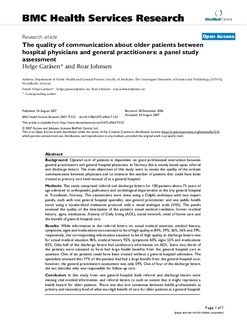| dc.description.abstract | Background: Optimal care of patients is dependent on good professional interaction between
general practitioners and general hospital physicians. In Norway this is mainly based upon referral
and discharge letters. The main objectives of this study were to assess the quality of the written
communication between physicians and to estimate the number of patients that could have been
treated at primary care level instead of at a general hospital.
Methods: This study comprised referral and discharge letters for 100 patients above 75 years of
age admitted to orthopaedic, pulmonary and cardiological departments at the city general hospital
in Trondheim, Norway. The assessments were done using a Delphi technique with two expert
panels, each with one general hospital specialist, one general practitioner and one public health
nurse using a standardised evaluation protocol with a visual analogue scale (VAS). The panels
assessed the quality of the description of the patient's actual medical condition, former medical
history, signs, medication, Activity of Daily Living (ADL), social network, need of home care and
the benefit of general hospital care.
Results: While information in the referral letters on actual medical situation, medical history,
symptoms, signs and medications was assessed to be of high quality in 84%, 39%, 56%, 56% and 39%,
respectively, the corresponding information assessed to be of high quality in discharge letters was
for actual medical situation 96%, medical history 92%, symptoms 60%, signs 55% and medications
82%. Only half of the discharge letters had satisfactory information on ADL. Some two-thirds of
the patients were assessed to have had large health benefits from the general hospital care in
question. One of six patients could have been treated without a general hospital admission. The
specialists assessed that 77% of the patients had had a large benefit from the general hospital care;
however, the general practitioners assessment was only 59%. One of four of the discharge letters
did not describe who was responsible for follow-up care.
Conclusion: In this study from one general hospital both referral and discharge letters were
missing vital medical information, and referral letters to such an extent that it might represent a
health hazard for older patients. There was also low consensus between health professionals at
primary and secondary level of what was high benefit of care for older patients at a general hospital. | nb_NO |
